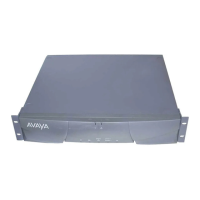Job Aid
July 2003
3
555-245-768, Issue 1
Comcode 700281124
Initial Onsite Tasks
NOTE:
Except where noted in the following checklist, see "Upgrading the Avaya S8700 Media Server
Configurations" documentation on the Avaya S8300 and S8700 Media Server Library CD-ROM,
555-233-825, Issue 3, for details on tasks.
Checklist 2. Initial Tasks for Replacing a Hard Drive on an S8700 Media Server
9 Task Description
1 Log into Web Interface of the
Active S8700 Media Server
Connect to the Services port on the back of the media server. Open a
browser on your laptop, and using 192.11.13.6, log onto the Mainte-
nance Web Interface.
Note: You must use the initial installation craft password.
2 Determine the Software Release
of the Existing Media Server and
Necessary Patches
(For R1.2 and R1.3 replacement only) Under Server Configuration
and Upgrades, click View Software Version.
(For R1.0/R1.1.x replacement only) The system must be upgraded
to R1.2 software.
3 (For R1.0/R1.1 replacement
only) Determine If the Customer
Has LSPs
Ask the customer, or check by using a terminal emulator to access
the Communication Manager SAT command prompt screen. Use the
192.11.13.6 IP address.
Type list configuration media-gateway number, where number is
the number of a G700 media gateway. If ICC appears in slot 1, the
device is an LSP. Repeat for each G700 Media Gateway.
4 (For R1.0/R1.1 replacement
only) If There Are LSPs,
Upgrade LSPs and Their
Respective G700 Media Gate-
ways to R1.2
The LSPs must be on R1.2 before upgrading the other media server
to R1.2. Also, upgrade the firmware for each G700 Media Gateway,
including media modules and P330 stack processors.
Note: Be sure to stop Communication Manager software on each
LSP (use stop -acfn command) until the media server has been
upgraded. For detailed information, see Installation and Upgrades for
the Avaya G700 Media Gateway Controlled by An S8300 Media
Server or an S8700 Media Server, 555-234-100.
6 Determine If the Customer Has a
Recent Backup of Data
On the Web Interface, select View Backup Log to search for backup
files. Check for the types of data and dates. Verify that there are suc-
cessful backups that could appropriately be restored, if necessary.
Verify with the customer that if the backups were to a LAN server, you
have access permissions to restore the data, if necessary.

